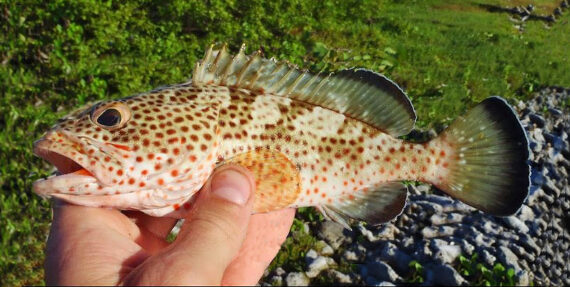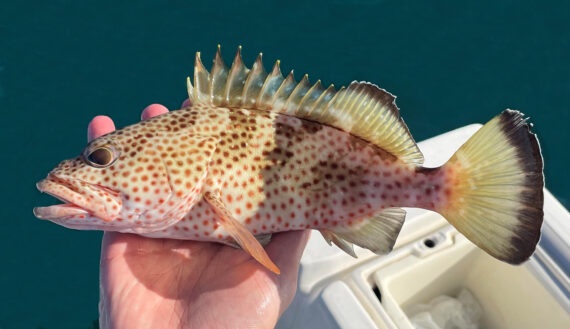Red Hind, Epinephelus guttatus
 Red Hind, Epinephelus guttatus. Fish caught from coastal waters off Key Largo, Florida, November 2020. Length: 18 cm (7.1 inches). Catch, photograph, and identification courtesy of Josh Leisen (joshadventures.com), Gaylord, Michigan.
Red Hind, Epinephelus guttatus. Fish caught from coastal waters off Key Largo, Florida, November 2020. Length: 18 cm (7.1 inches). Catch, photograph, and identification courtesy of Josh Leisen (joshadventures.com), Gaylord, Michigan.
 Red Hind, Epinephelus guttatus. Fish caught from coastal waters off Nassau, Bahamas, November 2022. Length 25 cm (10 inches). Catch, photograph and identification courtesy of James Lafontaine, Long Island, New York.
Red Hind, Epinephelus guttatus. Fish caught from coastal waters off Nassau, Bahamas, November 2022. Length 25 cm (10 inches). Catch, photograph and identification courtesy of James Lafontaine, Long Island, New York.
The Red Hind, Epinephelus guttatus, is a member of the Grouper or Epinephelidae Family, that is known in Mexico as cabrilla colorada. Globally, there are one hundred species in the genus Epinephelus, of which eleven are found in Mexican waters, six in the Atlantic and five in the Pacific Ocean.
The Red Hind has a robust, compressed body that has a depth that is 32% to 37% of standard length that is deepest at the origin of the dorsal fin. They have a grayish-green to light brown coloration dorsally that transitions to white ventrally and are covered with numerous well-spaced dull orange-red to brown spots on the body, fins and head. They have five faint diagonal bars, formed by darker spots, on their sides. Their anal, caudal, and second dorsal fins are olive with a dark band near the edge with a narrow white margin. The juveniles are similar in color to the adults but have larger spots. Their gill covers have three flat spines on the margins. Their anal fin has 3 spines and 8 rays; the caudal fin is slightly lunate; their dorsal fin has 11 spines, with spines 3 and 4 being the longest, and 15 or 16 rays; their pectoral fins have 16 to 18 rays and are symmetrically rounded; and, their pelvic fins are shorter than the pectoral fins and originate under the pectoral fins. They have 24 to 26 gill rakers. They are covered with rough cycloid scales.
The Red Hind is a solitary highly territorial fish that is found within shallow reefs and above rocky substrate at depths up to 180 m (590 feet). They are fast growing and short lived. They reach a maximum of 76 cm (2 feet 6 inches) in length and 8.3 kg (18 lbs 4 oz) in weight. As of January 1, 2024, the International Game Fish Association world record stood at 4.8 kg (10 lbs 8 oz) with the fish caught from coastal waters off Florida, September 2021. They feed primarily on crabs, mantis shrimp and other crustaceans, fishes and octopus. Red Hind are protogynous hermaphrodites, changing from females to males at mid-life. Most fish that are larger than 40 cm (16 inches) are males and females significantly outnumber males. Reproduction occurs in annual cycles from January to March based on the phase of the moon. They congregate in large aggregations in historical locations with fish traveling up to 10 miles to spawn at a particular site. Spawning occurs in harems of one male and up to six females. The females rest on or close to the bottom while males patrol and defend the territory. During mating that produce distinctive sounds that have drawn the attention of the scientific community. They have lifespans of up to twenty-two years. The Red Hind is poorly studied with very limited information available about their lifestyle and behavioral patterns including specific details on age, growth, longevity, movement patterns, diet, habitat use, and reproduction.
The Red Hind is a resident of all Mexican waters of the Atlantic Ocean including the Gulf of Mexico and the east coast of the Yucatán Peninsula in the Caribbean. They are caught in abundance off the Campeche Bank off the Yucatán Peninsula and in lesser quantities off of the coasts of Campeche, Quintana Roo, Tabasco, Tampico and Veracruz. Catches from these areas in general are currently considered to be in an overall state of decline.
The Red Hind is similar to and can be confused with the Coney, Cephalopholis fulva (small blue-edged spots), the Graysby, Cephalopholis cruentata (dark orange brown spots; fins without white margins), and, the Rock Hind, Epinephelus adscensionis (black saddles at the base of the dorsal fin, rounded caudal fin).
From a conservation perspective the Red Hind is currently considered to be of Least Concern with stable, widely distributed populations. Although small in stature they are an important focus food fish by both commercial and recreational fishermen in the Caribbean that are readily caught via hook and line, nets, traps and by spearfishermen. They are exported from Mexico to the United States. They are known, however, to contain Ciguatera Toxin. They are popular with underwater recreational divers as they are very approachable. Their long-term viability is threatened by habitat destruction caused by human development and pollution and by overfishing. As they aggregate in large schools on annual cycles in well known locations they become “sitting ducks” to fisherman. They are also potentially threatened by the recent introduction of the highly invasive Red Lionfish, Pterois volitans. The majority of the catch by inshore artisanal fishermen are sexually immature juveniles. Minimal regulations have been put in place, including spawning season closures, in many locations within the Caribbean but are poorly enforced. Accurate catch levels and population trends are not available as catches of Red Hind are combined with all grouper catches from a specific area.